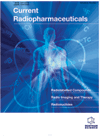- Home
- A-Z Publications
- Current Radiopharmaceuticals
- Previous Issues
- Volume 12, Issue 1, 2019
Current Radiopharmaceuticals - Volume 12, Issue 1, 2019
Volume 12, Issue 1, 2019
-
-
Utility of Molecular Imaging with 2-Deoxy-2-[Fluorine-18] Fluoro-DGlucose Positron Emission Tomography (18F-FDG PET) for Small Cell Lung Cancer (SCLC): A Radiation Oncology Perspective
More LessBackground and Objective: Although accounting for a relatively small proportion of all lung cancers, small cell lung cancer (SCLC) remains to be a global health concern with grim prognosis. Radiotherapy (RT) plays a central role in SCLC management either as a curative or palliative therapeutic strategy. There has been considerable progress in RT of SCLC, thanks to improved imaging techniques leading to accurate target localiz Read More
-
-
-
[68Ga]-Dota Peptide PET/CT in Neuroendocrine Tumors: Main Clinical Applications
More LessObjective: Neuroendocrine Neoplasms (NENs) are generally defined as rare and heterogeneous tumors. The gastrointestinal system is the most frequent site of NENs localization, however they can be found in other anatomical regions, such as pancreas, lungs, ovaries, thyroid, pituitary, and adrenal glands. Neuroendocrine neoplasms have significant clinical manifestations depending on the production of active peptide. Meth Read More
-
-
-
Evaluating the Radioprotective Effect of Curcumin on Rat's Heart Tissues
More LessBackground: Heart injury is one of the most important concerns after exposure to a high dose of radiation in chest cancer radiotherapy or whole body exposure to a radiation disaster. Studies have proposed that increased level of inflammatory and pro-fibrotic cytokines following radiotherapy or radiation events play a key role in the development of several side effects such as cardiovascular disorders. In the current study, we Read More
-
-
-
Determination of Gamma Camera's Calibration Factors for Quantitation of Diagnostic Radionuclides in Simultaneous Scattering and Attenuation Correction
More LessAuthors: Afrouz Asgari, Mansour Ashoor, Leila Sarkhosh, Abdollah Khorshidi and Parvaneh ShokraniObjective: The characterization of cancerous tissue and bone metastasis can be distinguished by accurate assessment of accumulated uptake and activity from different radioisotopes. The various parameters and phenomena such as calibration factor, Compton scattering, attenuation and penetration intrinsicallyinfluence calibration equation, and the qualification of images as well. Methods: The camera calibration factor (C Read More
-
-
-
Dosimetry and Toxicity Studies of the Novel Sulfonamide Derivative of Sulforhodamine 101([18F]SRF101) at a Preclinical Level
More LessAuthors: Ingrid Kreimerman, Erick Mora-Ramirez, Laura Reyes, Manuel Bardiès, Eduardo Savio and Henry EnglerBackground: The SR101 N-(3-[18F]Fluoropropyl) sulfonamide ([18F]SRF101) is a Sulforhodamine 101 derivative that was previously synthesised by our group. The fluorescent dye SR101 has been reported as a marker of astroglia in the neocortex of rodents in vivo. Objective: The aim of this study was to perform a toxicological evaluation of [18F]SRF101 and to estimate human radiation dosimetry based on preclinical studies. Read More
-
-
-
Synthesis of [18F]FAZA Using Nosyl and Iodo Precursors for Nucleophilic Radiofluorination
More LessAuthors: William Sun, Cheryl Falzon, Ebrahim Naimi, Ali Akbari, Leonard I. Wiebe, Manju Tandon and Piyush KumarBackground: 1-α-D-(5-Deoxy-5-[18F]fluoroarabinofuranosyl)-2-nitroimidazole ([18F]FAZA) is manufactured by nucleophilic radiofluorination of 1-α-D-(2’,3’-di-O-acetyl-5’-O-toluenesulfonylarabinofuranosyl)- 2-nitroimidazole (DiAcTosAZA) and alkaline deprotection to afford [18F]FAZA. High yields (>60%) under optimized conditions frequently revert to low yields (<20%) in large scale, automated syntheses. Competing side reaction Read More
-
-
-
[18F]Amylovis as a Potential PET Probe for β-Amyloid Plaque: Synthesis, In Silico, In vitro and In vivo Evaluations
More LessAuthors: Suchitil Rivera-Marrero, Laura Fernández-Maza, Samila León-Chaviano, Marquiza Sablón-Carrazana, Alberto Bencomo-Martínez, Alejandro Perera-Pintado, Anais Prats-Capote, Florencia Zoppolo, Ingrid Kreimerman, Tania Pardo, Laura Reyes, Marcin Balcerzyk, Geyla Dubed-Bandomo, Daymara Mercerón-Martínez, Luis A. Espinosa-Rodríguez, Henry Engler, Eduardo Savio and Chryslaine Rodríguez-TantyBackground: Alzheimer’s disease (AD) is the most common form of dementia. Neuroimaging methods have widened the horizons for AD diagnosis and therapy. The goals of this work are the synthesis of 2-(3-fluoropropyl)-6-methoxynaphthalene (5) and its [18F]-radiolabeled counterpart ([18F]Amylovis), the in silico and in vitro comparative evaluations of [18F]Amylovis and [11C]Pittsburg compound B (PIB) and the in vivo Read More
-
-
-
Biochemical and Histopathological Evaluation of the Radioprotective Effects of Melatonin Against Gamma Ray-Induced Skin Damage
More LessBackground: Radiotherapy is one of the treatment methods for cancers using ionizing radiations. About 70% of cancer patients undergo radiotherapy. Radiation effect on the skin is one of the main complications of radiotherapy and dose limiting factor. To ameliorate this complication, we used melatonin as a radioprotective agent due to its antioxidant and anti-inflammatory effects, free radical scavenging, improving o Read More
-
-
-
Synthesis of Deuterium Labeled 5, 5-Dimethyl-3-(α, α, α-trifluoro-4-nitro-m-tolyl) Hydantoin
More LessObjective: Stable and non-radioactive isotope labeled compounds gained significance in recent drug discovery and other various applications such as bio-analytical studies. The modern bioanalytical techniques can study the adverse therapeutic effects of drugs by comparing isotopically labeled internal standards. A well-designed labeled compound can provide high-quality information about the identity and quantification of drug- Read More
-
-
-
Choline-PET/CT in the Differential Diagnosis Between Cystic Glioblastoma and Intraparenchymal Hemorrhage
More LessObjective: Glioblastoma multiforme (GBM) represents the most common and malignant glioma, accounting for 45%-50% of all gliomas. The median survival time for patients with glioblastoma is only 12-15 months after surgical, chemioterapic and radiotherapic treatment; a correct diagnosis is naturally fundamental to establish a rapid and correct therapy. Non-invasive imaging plays a pivotal role in each phase of the diagnostic Read More
-
Volumes & issues
Most Read This Month
Article
content/journals/crp
Journal
10
5
false
en


